
ACC Background and Objectives
Adaptive Cruise Control (ACC) has become a key innovation in modern vehicle safety and convenience. It marks a major step toward autonomous driving. Automakers began developing ACC in the late 1990s. Early systems maintained a set speed and distance from the car ahead. Over time, the technology evolved from a luxury feature to a standard in many vehicles.
What is adaptive cruise control? Eureka Technical Q&A explains that it’s an advanced driver-assistance system that uses radar, sensors, and AI to maintain a safe distance from vehicles ahead—automatically adjusting your speed for a smoother, smarter drive.
ACC improves comfort and safety by automatically adjusting speed to keep a safe following distance. The system uses radar or lidar sensors to detect vehicles ahead. It combines real-time data with advanced control algorithms for smooth, intelligent driving. These systems respond instantly to traffic changes without driver input.
Today’s ACC systems can handle stop-and-go traffic with ease. They track multiple vehicles and adjust speed accordingly. Many systems also work with navigation to prepare for curves, intersections, or road changes. This capability creates a more intuitive and safer driving experience.
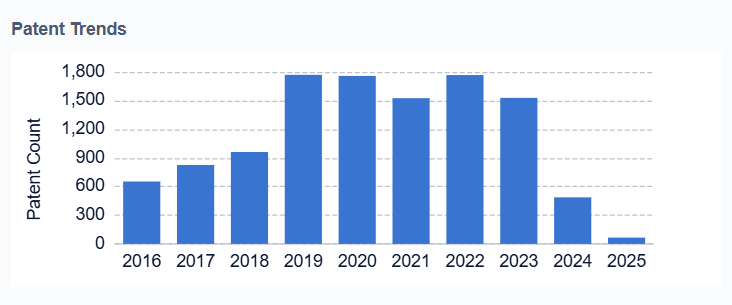
Advancements in sensors, computing power, and AI have fueled the rapid progress of ACC. These improvements make detection and prediction faster and more accurate. As a result, ACC now adapts better to dynamic driving conditions.
Looking ahead, ACC will integrate with vehicle-to-vehicle (V2V) and vehicle-to-infrastructure (V2I) communications. These connections will boost safety by sharing traffic data in real time. Engineers are also working to improve ACC’s performance in bad weather and complex urban environments.
ACC forms the foundation for many advanced driver-assistance systems (ADAS). It will remain critical as the industry moves toward fully autonomous vehicles. Future systems will coordinate with lane keeping, emergency braking, and traffic jam assist features. This integration ensures vehicles can safely navigate without constant human input.
In short, ACC plays a vital role in transforming transportation. It supports safer roads, smoother traffic flow, and reduced emissions. As automakers refine the technology, they bring us closer to a future of truly autonomous driving.
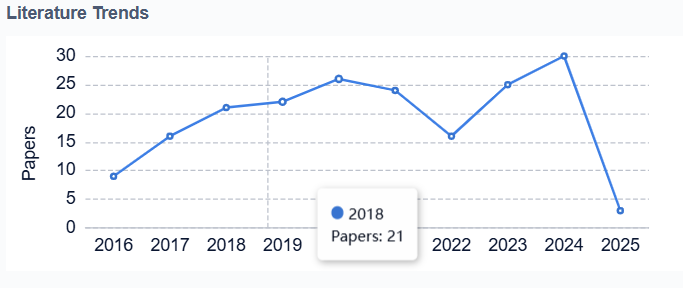
Market Analysis for ACC Systems
The Adaptive Cruise Control (ACC) market has been experiencing significant growth in recent years, driven by increasing demand for advanced driver assistance systems (ADAS) and the growing emphasis on vehicle safety. The global ACC market size was valued at approximately $7.5 billion in 2020 and is projected to reach $13.5 billion by 2025, growing at a CAGR of around 12% during the forecast period. This growth is primarily attributed to the rising consumer awareness about vehicle safety features, stringent government regulations regarding road safety, and the increasing adoption of autonomous vehicles.
The passenger car segment dominates the ACC market, accounting for over 70% of the market share. This is due to the higher adoption rate of ACC systems in luxury and premium vehicles, which are primarily passenger cars. However, the commercial vehicle segment is expected to witness the highest growth rate during the forecast period, driven by the increasing focus on fleet safety and the potential for fuel savings in long-haul transportation.
Geographically, North America and Europe are the leading markets for ACC systems, collectively accounting for over 60% of the global market share. This dominance is attributed to the high penetration of luxury vehicles, stringent safety regulations, and the presence of major automotive manufacturers in these regions. However, the Asia-Pacific region is expected to witness the highest growth rate in the coming years, driven by the increasing adoption of advanced automotive technologies in countries like China, Japan, and South Korea.
The ACC market is characterized by intense competition among key players such as Robert Bosch GmbH, Continental AG, Delphi Automotive PLC, Denso Corporation, and Magna International Inc. These companies are focusing on strategic partnerships, mergers and acquisitions, and product innovations to gain a competitive edge in the market. For instance, in 2020, ZF Friedrichshafen AG acquired WABCO Holdings Inc., strengthening its position in the commercial vehicle market and expanding its ACC portfolio.
The market is also witnessing a shift towards more advanced ACC systems that incorporate artificial intelligence and machine learning algorithms. These next-generation ACC systems offer enhanced functionalities such as predictive cruise control, which can anticipate traffic conditions and adjust vehicle speed accordingly. Additionally, the integration of ACC with other ADAS features like lane-keeping assist and automatic emergency braking is becoming increasingly common, paving the way for more comprehensive safety solutions.
Despite the positive outlook, the ACC market faces challenges such as high system costs, which limit its adoption in mid-range and economy vehicles. However, ongoing technological advancements and economies of scale are expected to drive down costs in the coming years, making ACC systems more accessible to a wider range of vehicles and consumers.
ACC Technology Status and Challenges
Adaptive Cruise Control (ACC) technology has made significant strides in recent years, becoming a cornerstone of advanced driver assistance systems (ADAS) in modern vehicles. The current status of ACC technology reflects a mature yet evolving field, with ongoing challenges that drive innovation and research. Globally, ACC systems have been widely adopted by major automotive manufacturers, with varying levels of sophistication and capabilities. The technology has progressed from simple speed maintenance to more advanced features that incorporate radar, lidar, and camera systems for enhanced object detection and distance measurement.
Despite its widespread implementation, ACC technology faces several key challenges. One of the primary obstacles is the accurate detection and classification of objects in complex traffic scenarios. Current systems sometimes struggle to differentiate between stationary and moving objects, particularly in adverse weather conditions or when encountering non-standard road layouts. This limitation can lead to false positives or missed detections, potentially compromising safety.
Another significant challenge lies in the seamless integration of ACC with other vehicle systems and the broader traffic ecosystem. As vehicles become more connected, there is a growing need for ACC systems to communicate with infrastructure and other vehicles, paving the way for cooperative adaptive cruise control (CACC). However, standardization and interoperability issues persist, hindering the full realization of these advanced capabilities.
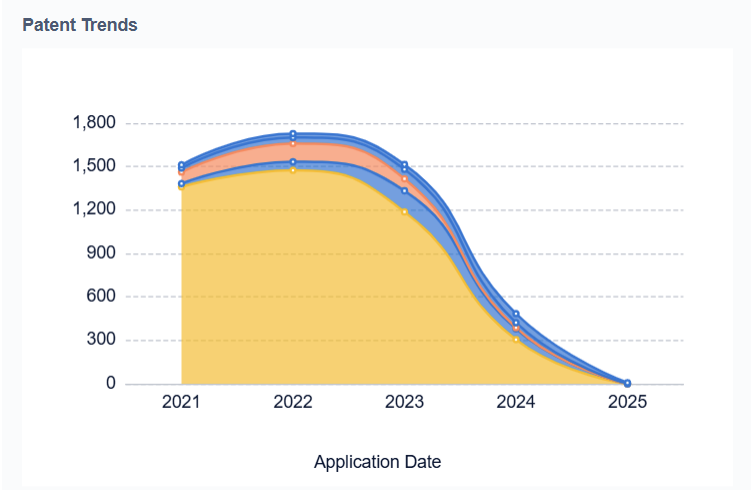
The human-machine interface (HMI) remains a critical area for improvement. Ensuring that drivers understand the system’s capabilities and limitations, and can effectively take control when necessary, is crucial for safe operation. This challenge extends to the broader issue of user acceptance and trust in ACC technology, which varies across different demographics and regions.
From a technical standpoint, the development of more robust and efficient algorithms for real-time decision-making in ACC systems is an ongoing challenge. These algorithms must balance performance with computational efficiency to meet the stringent requirements of automotive-grade hardware.
Geographically, the development and adoption of ACC technology show distinct patterns. While North America, Europe, and East Asia (particularly Japan and South Korea) lead in research and implementation, emerging markets are rapidly catching up. China, in particular, has seen a surge in ACC development, driven by its burgeoning automotive industry and supportive government policies.
Regulatory frameworks and standards for ACC technology vary significantly across regions, presenting challenges for global automotive manufacturers. Harmonizing these regulations while addressing region-specific traffic conditions and driving cultures remains a complex task for both industry players and policymakers.
As ACC technology continues to evolve, addressing these challenges will be crucial for realizing its full potential in enhancing road safety, improving traffic efficiency, and paving the way for higher levels of vehicle autonomy.
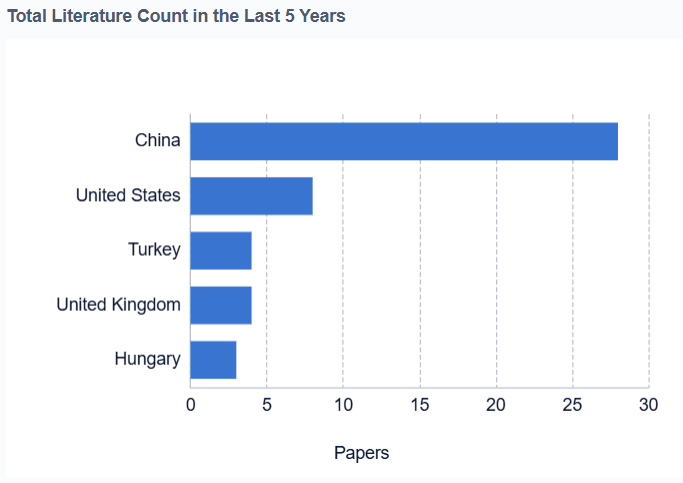
ACC Development Timeline

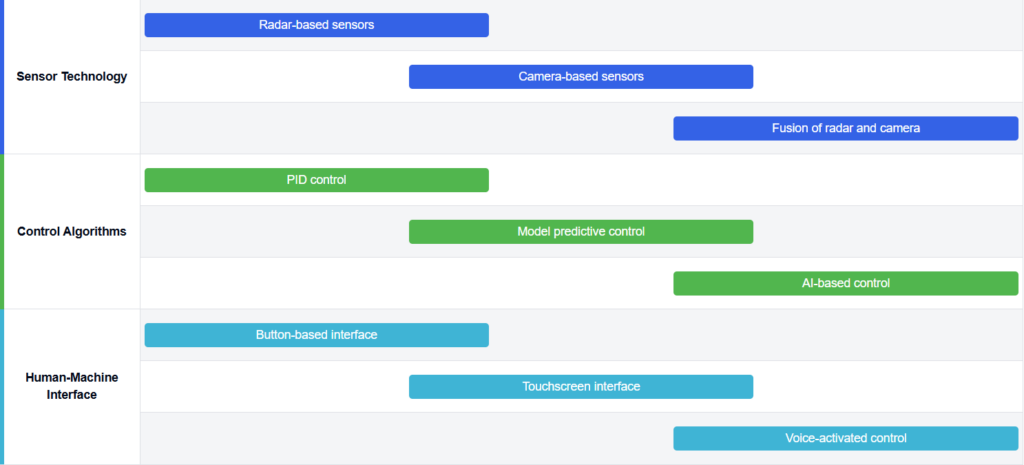
Key Players in ACC IndustryEdit Player
The Adaptive Cruise Control (ACC) technology market is in a mature growth stage, with significant market size and widespread adoption across the automotive industry. The global ACC market is projected to expand substantially in the coming years, driven by increasing demand for advanced driver assistance systems. Technologically, ACC has reached a high level of maturity, with major players like GM Global Technology Operations LLC, Robert Bosch GmbH, and Continental Automotive Systems, Inc. continuously refining and enhancing their systems. Companies such as Toyota Motor Corp., Ford Global Technologies LLC, and Nissan Motor Co., Ltd. are also heavily invested in ACC development, focusing on integrating it with other advanced features to create more comprehensive autonomous driving solutions.
 Robert Bosch GmbH
Robert Bosch GmbH
Technical Solution
Bosch’s Adaptive Cruise Control (ACC) system uses radar and camera sensors to maintain a safe distance from the vehicle ahead. It can automatically adjust the vehicle’s speed to match traffic conditions, even bringing the car to a complete stop if necessary. The system incorporates predictive functions that can anticipate traffic situations based on navigation data and adjust vehicle speed accordingly. Bosch’s ACC also features a stop-and-go function for congested traffic, allowing the vehicle to autonomously follow the car in front at low speeds.
Strengths: Advanced sensor fusion technology, predictive capabilities, and seamless integration with other driver assistance systems. Weaknesses: Reliance on clear road markings and good weather conditions for optimal performance.
 Toyota Motor Corp.
Toyota Motor Corp.
Technical Solution
Toyota’s Dynamic Radar Cruise Control (DRCC) system uses millimeter-wave radar and a camera to detect vehicles ahead and maintain a preset following distance. The system can operate at all speeds, including bringing the vehicle to a complete stop in traffic. Toyota’s DRCC incorporates a curve speed reduction function, which automatically slows the vehicle when approaching a curve based on the navigation system’s map data. The latest versions also include a Lane Tracing Assist feature, which works in conjunction with ACC to keep the vehicle centered in its lane.
Strengths: Comprehensive integration with other safety systems, curve speed reduction functionality, and all-speed range operation. Weaknesses: May be overly cautious in some situations, potentially leading to slower traffic flow.
 Hyundai Motor Co., Ltd.
Hyundai Motor Co., Ltd.
Technical Solution
Hyundai’s Smart Cruise Control (SCC) system uses front-facing radar and camera sensors to maintain a safe distance from the vehicle ahead. The system can operate from 0 to 180 km/h, adjusting speed automatically based on traffic conditions. Hyundai’s SCC incorporates machine learning algorithms to adapt to the driver’s habits and preferences over time, providing a more personalized driving experience. The system also features a navigation-based SCC function, which can automatically reduce speed in curves or on highway exits based on map data.
Strengths: Adaptive learning capabilities, wide speed range operation, and integration with navigation data for proactive speed adjustments. Weaknesses: May require frequent updates to maintain optimal performance and adapt to new road conditions.
 General Motors Co.
General Motors Co.
Technical Solution
GM’s Super Cruise system is an advanced adaptive cruise control technology that combines precision LiDAR map data, high-precision GPS, a driver attention system and a network of cameras and radar sensors. It allows for hands-free driving on compatible highways, maintaining speed and lane position. The system uses real-time cameras, sensors and GPS to detect every curve, helping the vehicle stay centered in the lane and maintain a safe following distance. Super Cruise also incorporates a Driver Attention System that uses a small camera on the steering column to ensure the driver is paying attention to the road.
Strengths: Hands-free operation on compatible highways, high-precision mapping for enhanced accuracy, and advanced driver monitoring system. Weaknesses: Limited to pre-mapped highways and requires constant driver attention despite hands-free capability.
Current ACC Technical Solutions
Speed and distance control algorithmsAdaptive Cruise Control systems employ sophisticated algorithms to manage vehicle speed and maintain safe distances from other vehicles. These algorithms process data from various sensors to adjust the vehicle’s speed automatically, ensuring smooth acceleration, deceleration, and maintaining a preset following distance.
- Adaptive cruise control algorithmsAdaptive cruise control systems use advanced algorithms to maintain a safe distance from the vehicle ahead while controlling speed. These algorithms process sensor data to adjust vehicle speed and distance dynamically, ensuring smooth and safe operation in various traffic conditions.
- Sensor fusion for speed and distance controlModern speed and distance control systems integrate data from multiple sensors such as radar, lidar, and cameras. This sensor fusion approach enhances the accuracy and reliability of distance measurements and speed adjustments, enabling more precise control in complex driving scenarios.
- Predictive control strategiesAdvanced speed and distance control systems employ predictive algorithms to anticipate changes in traffic flow and road conditions. These strategies allow the system to proactively adjust vehicle speed and following distance, resulting in smoother transitions and improved fuel efficiency.
- Machine learning-based optimizationIncorporating machine learning techniques into speed and distance control algorithms allows for continuous improvement and adaptation to different driving styles and environments. These systems can learn from historical data and driver behavior to optimize performance over time.
Sensor integration for ACC systems
ACC systems integrate multiple sensors, including radar, lidar, and cameras, to detect and track surrounding vehicles and obstacles. This sensor fusion approach enhances the accuracy of distance measurements and speed calculations, enabling more precise control of the vehicle’s speed and position relative to other road users.Expand
User interface and customization features
Modern ACC systems offer user-friendly interfaces that allow drivers to set desired speeds and following distances. Some systems provide customization options, enabling drivers to adjust sensitivity levels and choose between different driving modes, such as eco-friendly or sport modes, to suit their preferences and driving conditions.Expand
Integration with other ADAS features
ACC is often integrated with other Advanced Driver Assistance Systems (ADAS) such as lane keeping assist, emergency braking, and traffic sign recognition. This integration enhances overall vehicle safety and provides a more comprehensive autonomous driving experience, allowing for smoother transitions between different assistance features.Expand
Predictive and adaptive capabilities
Advanced ACC systems incorporate predictive algorithms and machine learning techniques to anticipate traffic flow changes and road conditions. These capabilities allow the system to proactively adjust vehicle speed and following distance, improving overall efficiency and safety while reducing the need for sudden braking or acceleration.
Core ACC Innovations




Future ACC Research Directions
Advanced AI-powered ACC
AI-powered Adaptive Cruise Control (ACC) marks a major leap in vehicle automation and driver-assistance technology. It goes far beyond traditional cruise systems by using artificial intelligence and machine learning to make real-time driving decisions. This system combines radar, LiDAR, and cameras to build a full 360-degree view of the vehicle’s surroundings.
Machine learning algorithms process large datasets to predict traffic behavior more accurately than basic rule-based systems. Unlike older systems, AI continuously learns and updates its driving models through experience. It constantly analyzes inputs from vehicle-to-vehicle (V2V) and vehicle-to-infrastructure (V2I) networks to maintain optimal speed and spacing.
As a result, the system predicts vehicle and pedestrian movement and adjusts speed or lane position accordingly. It reacts smoothly to stop-and-go traffic, sudden braking, or lane changes from nearby vehicles. This predictive capability helps reduce hard braking and aggressive acceleration, making rides safer and more comfortable.
Moreover, AI-powered ACC personalizes itself by learning the driver’s habits and preferred driving style. It fine-tunes responsiveness while still maintaining safety and compliance with road rules. Drivers experience smoother transitions during speed changes and lane shifts.
In addition, the system adapts to traffic conditions by adjusting speed to conserve fuel and reduce unnecessary engine strain. By analyzing traffic flow, it limits sudden accelerations and braking, promoting efficiency. It also navigates complex situations like roundabouts, intersections, and merging lanes with minimal driver input.
The AI system factors in weather, road quality, and local traffic laws to provide context-aware cruise control. It ensures optimal performance during rain, snow, or low-visibility conditions. With over-the-air updates, automakers can upgrade the system without physical changes or service visits.
As the AI gathers more data, it evolves and handles new driving challenges with greater confidence. This scalability keeps vehicles equipped with AI-powered ACC at the cutting edge of automotive innovation.
Strengths: Highly adaptive and intelligent, capable of handling complex traffic scenarios; Improves safety through predictive analysis and faster reaction times; Enhances fuel efficiency and passenger comfort; Customizable to individual driving styles; Scalable and upgradable through over-the-air updates. Weaknesses: Requires significant computational power and may increase vehicle cost; Dependence on complex sensor arrays that need regular maintenance; Potential privacy concerns due to data collection and analysis; May face regulatory challenges in some jurisdictions; Risk of over-reliance on automation, potentially reducing driver alertness.
Cooperative ACC with V2X Integration
Cooperative Adaptive Cruise Control (CACC) with V2X integration is transforming how vehicles manage speed, spacing, and traffic flow. Unlike traditional ACC, this advanced system enables vehicles to communicate with each other and the surrounding infrastructure. It supports vehicle-to-everything (V2X) connectivity, including V2V, V2I, V2P, and V2N communications.
Each vehicle sends and receives real-time data, creating a smarter, more coordinated traffic environment. CACC systems form vehicle platoons, where cars travel closely together at high speeds. The lead vehicle shares its speed and braking inputs with the following cars. As a result, trailing vehicles respond instantly without relying solely on sensors.
This coordination reduces braking delays and minimizes fuel consumption by lowering aerodynamic drag. It also helps maintain smoother traffic flow and improves overall driving efficiency. Moreover, CACC lowers the risk of rear-end collisions by enabling faster reaction times.
V2I communication adds another layer of intelligence. Vehicles receive updates on traffic signals, road conditions, and construction zones. For example, a vehicle can adjust speed based on an upcoming green light to avoid unnecessary stops. Similarly, alerts about hazards like icy roads help drivers respond in advance.
With V2P integration, vehicles detect pedestrians and cyclists carrying connected devices. This ensures safety, even when road users are not in direct view. The system instantly processes their location and adjusts vehicle behavior to avoid collisions.
V2N connectivity takes things further by linking vehicles to cloud services. It offers real-time traffic forecasts, map updates, and smart route suggestions. These features help distribute traffic more evenly across roadways and reduce travel delays.
As the technology advances, CACC with V2X sets the stage for autonomous vehicles. It creates a predictable and cooperative driving environment, making full automation more achievable. By combining communication, intelligence, and automation, this system promises safer, faster, and greener roadways.
Strengths: Significantly enhances traffic efficiency and reduces congestion; Improves safety through advanced warning systems and broader awareness; Enables fuel savings through platooning and optimized traffic flow; Provides a foundation for higher levels of vehicle automation; Offers scalable benefits as more vehicles and infrastructure adopt the technology. Weaknesses: Requires widespread adoption and infrastructure investment to realize full benefits; Raises cybersecurity concerns due to increased connectivity; May face standardization challenges across different manufacturers and regions; Potential for system overload in areas with high vehicle density; Privacy issues related to the constant exchange of vehicle and personal data.
Safety and Regulatory Framework
Adaptive Cruise Control (ACC) technology continues to grow in modern vehicles, prompting the need for strong safety regulations. As ACC systems become more advanced, global regulatory bodies are working to set clear safety guidelines.
Regulators like the National Highway Traffic Safety Administration (NHTSA) and Euro NCAP lead efforts to test and certify ACC systems. They evaluate performance based on safe following distances, reaction to traffic changes, and operation in varied weather.
These standards aim to reduce accidents and ensure systems function reliably in real-world driving. Safety remains the top priority.
Human-machine interaction also plays a key role in ACC regulation. Guidelines require systems to provide clear status updates and warnings. Drivers must understand when to intervene and how the system behaves.
Designers must include intuitive displays and standardized alerts to reduce confusion. This prevents overreliance and keeps drivers engaged.
Cybersecurity concerns have grown as ACC systems use connected sensors and software. Hackers could pose risks if systems lack proper defenses. To address this, regulators now include cybersecurity protocols in ACC compliance checklists.
Automakers must implement protections to guard against data breaches or unauthorized control of the system. This ensures safe, secure operation.
As ACC technology evolves, so do regulations. New features like traffic sign recognition and predictive driving require updated safety rules. These additions often involve artificial intelligence and machine learning.
Regulators now develop standards specifically for AI-powered functions in ACC systems. This helps maintain control and safety as technology becomes smarter.
International alignment also matters. Automakers sell vehicles worldwide, so global coordination ensures consistent safety. Harmonizing testing standards across countries simplifies development and speeds up deployment.
Looking ahead, ACC regulations will expand to cover deeper ADAS integration and future automation. These guidelines will shape how drivers interact with increasingly autonomous systems.
By keeping pace with innovation, regulators ensure that ACC technology improves safety without creating new risks. These evolving standards support trust and adoption in markets worldwide.
Human-Machine Interface in ACC
The Human-Machine Interface (HMI) in Adaptive Cruise Control systems plays a critical role in safe and intuitive driver interaction. As ACC technology advances, user-friendly and responsive interface design has become increasingly important.
Modern HMI systems use visual, auditory, and haptic feedback to keep drivers informed without overwhelming them. Each method adds a unique layer of communication to enhance safety and usability.
Visual displays appear on dashboards or head-up displays (HUDs), showing ACC status, speed settings, and following distance. Color-coded icons and dynamic graphics help drivers interpret this data quickly and clearly.
Auditory alerts like chimes or voice prompts notify drivers of system changes or nearby hazards. These alerts allow drivers to stay aware without constantly watching the display.
Haptic feedback, such as steering wheel vibrations or pedal resistance, reinforces warnings during critical moments. This is especially helpful in low-visibility or high-noise environments.
Together, these multi-sensory cues create a safer, more responsive driving experience by reducing the need for constant visual monitoring.
Today’s HMI systems also emphasize adaptability. Engineers now use machine learning to analyze driver behavior and personalize the interface accordingly. The system learns user habits and adjusts feedback styles to improve interaction and reduce cognitive load.
Another exciting development involves augmented reality. AR-enhanced windshields display real-time data—like vehicle distance, lane position, or hazard warnings—directly in the driver’s field of view. This helps drivers keep their eyes on the road while staying informed.
Integration with smartphones and smartwatches is also becoming common. Drivers can now adjust ACC settings and receive updates through familiar mobile interfaces. This integration improves convenience and supports faster adoption of the technology.
Still, designers face challenges. Overloading drivers with too much information can increase risk. HMI systems must prioritize clarity and simplicity.
As ACC systems reach higher levels of autonomy, designers must ensure that drivers stay alert and aware. Future HMI solutions will need to balance automation with meaningful user engagement.
In summary, advanced HMI design will play a vital role in the success of ACC systems. Through personalization, multi-sensory feedback, and seamless connectivity, it helps drivers stay safe and in control.
To get detailed scientific explanations of what adaptive cruise control is, try Patsnap Eureka.


